Cruising Through the Magical Desert of Northern Sudan
Article and photos by Lies Ouwerkerk
Senior Contributing Editor
Published 10/5/2016
 |
| Girl at a water well in the middle of the magical desert in North Sudan: donkeys are tied to a long rope with a bucket in the end. |
With three Toyota Hilux cars piled high with camping equipment, chairs, table, stove, sleeping mats, propane tanks, food, water, mechanic tools and spare tires, our small caravan — comprising eight adventurers and a crew of three drivers, a guide, and a cook — veers off the highway into the unchartered territory of northern Sudan’s fascinating desert.
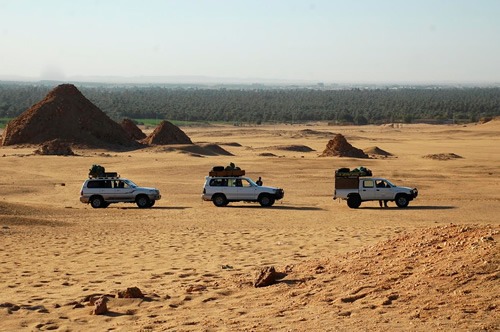 |
| We set off in a convoy through the desert. |
From now on, we will drive in convoy: the most experienced driver takes the lead in order to carefully scan the terrain, the rookie is assigned to the middle position, and another experienced driver follows in the rear. Occasionally, the first vehicle gets bogged down in the sand. Luckily, all 4WDs carry metal sand ladders to put under the spinning wheels, but it often needs an extra push from crew and passengers to get going again. During our 2-week expedition, there are also various flat tires, but since all three drivers are trained mechanics, that seems just a piece of cake for them.
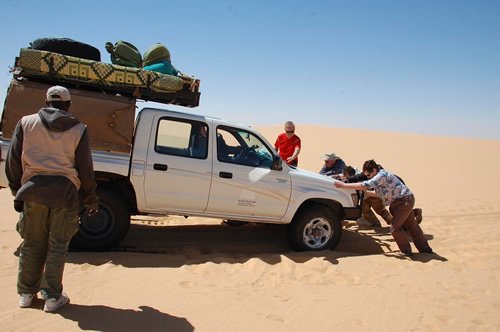 |
| On occasion, we got stuck in the sand. |
The Scenery
For days we will not see another vehicle while we venture through a great diversity of striking landscapes: extensive sand plains, golden dunes, amazing rock formations and massive boulders; long dried-out river beds (wadis) and oases rich in palm trees; and the mighty Nile River, serving as dividing line between the Nubian desert in the East, and the Libyan desert in the West.
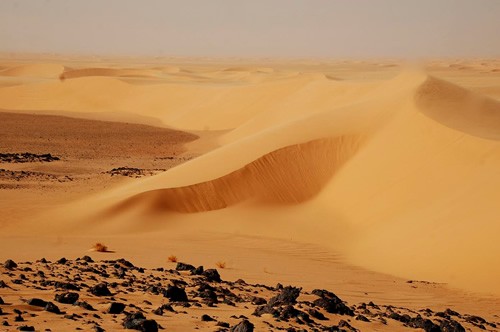 |
| Passing through magnificent sand dunes. |
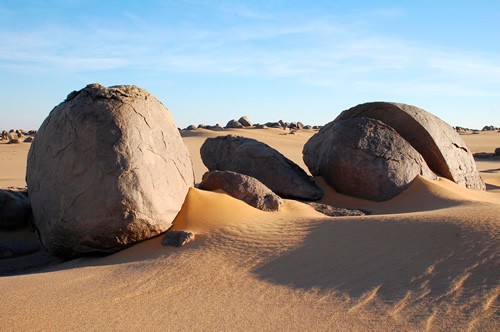 |
| Boulders in the desert. |
We drive through isolated villages in the Nile Valley, where white-robed men are riding their donkeys sidesaddle, or cultivate millet, wheat, and corn on their small plots.
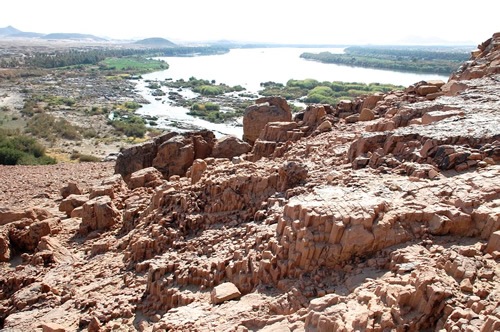 |
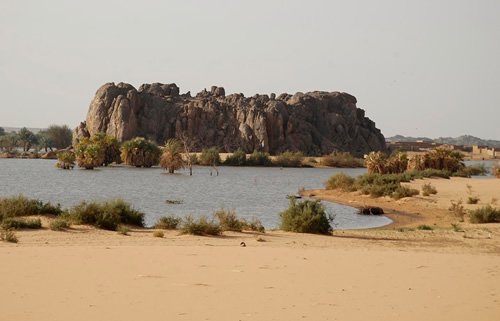 |
| Views of the Nile River. |
In the middle of nowhere, a nomadic Bisharin family tending their camels, sheep, and goats in the vicinity of a water well, invites us into their hut made of acacia branches. We bump into an isolated railway station where once a week a passenger train passes through, and a gold diggers camp nearby. And often half-hidden in the sands, we encounter a surprisingly large amount of rock engravings, wall paintings, temples, and pyramids of great historic value.
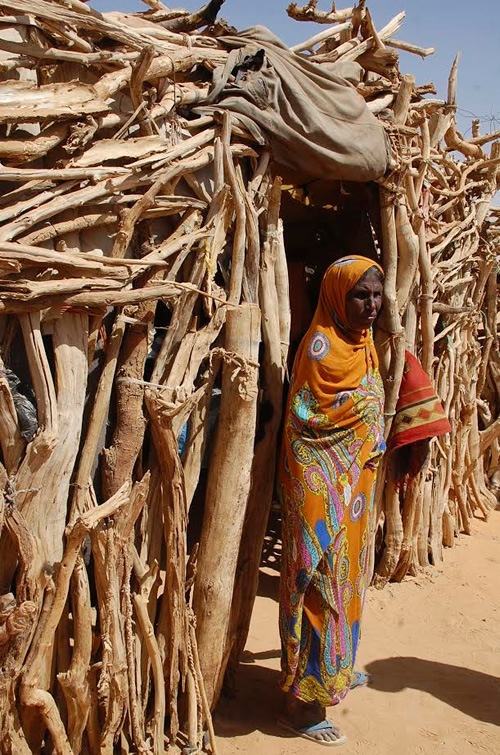 |
| Nomad woman in front of her home made from acacia branches. |
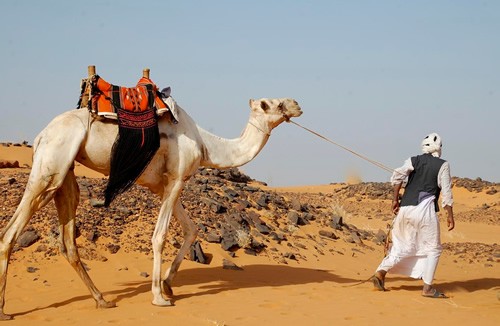 |
| Nomad man with a camel. |
History and Culture
The desert of northern Sudan is a true historic El Dorado, in particular for the geologists and archeologists among us. Discoveries pertaining to the origins of man have confirmed the existence of earliest human traces in the Nile Valley of Egypt and The Sudan, so the region is considered the "cradle of civilization." Searching carefully among the many stones lying around in the wadis, we do stumble once in a while upon chipped-off parts of larger stones, which seem to have been worked into domestic flint tools, tips of archers’ arrows, or sickles many thousands of years ago. Beware, though: it is strictly forbidden to take any fossils, stones, or archeological items out of the country, and checks at the airport upon leaving are routine practice!
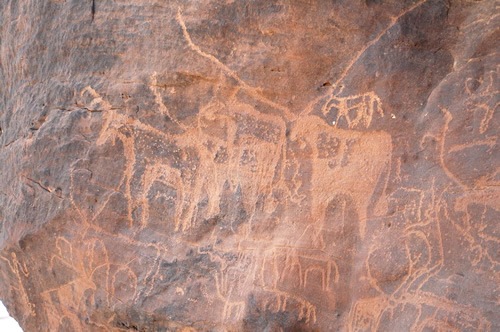 |
| We came across rock engravings. |
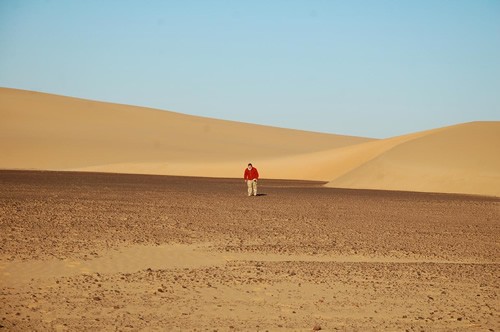 |
| In search of flint stones in a Wadi. |
Also, throughout the ages, Nubia — as the region along the Nile in northern Sudan and southern Egypt is called — has been an important trading center because of its strategic position between sub-Saharan Africa and the rest of the world. The legendary Black Pharaohs of Kush once rivaled Egypt, Greece, and Rome, and even ruled the empire of ancient Egypt for over a century around 800 BC. Their kingdoms left many traces behind, which, although severely plundered over subsequent centuries, still contained many domestic objects, pottery, beads, carvings, and wall decorations by the time archeologists started to discover them over the last two centuries.
These remnants include the ancient temple of Soleb situated on the west bank of the Nile River, and built by pharaoh Amenhotep III, around 1350 BC. With its many pillars and hieroglyphic inscriptions still intact, this sandstone temple is considered the most beautiful and best-preserved Egyptian temple in The Sudan.
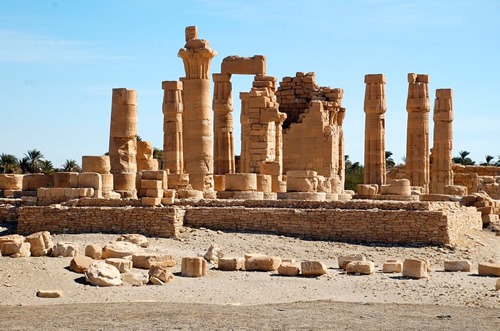 |
| The ancient temple of Soleb, built around 1350 BC. |
Equally impressive is the ancient site of Naga, developed during the Meroitic period, with a temple dedicated to Apedemak, a lion-headed warrior-god, and personal protector of the king. A few meters away, a small construction named “the kiosk,” clearly shows an amalgam of different cultures: Greek, Roman, and Egyptian.
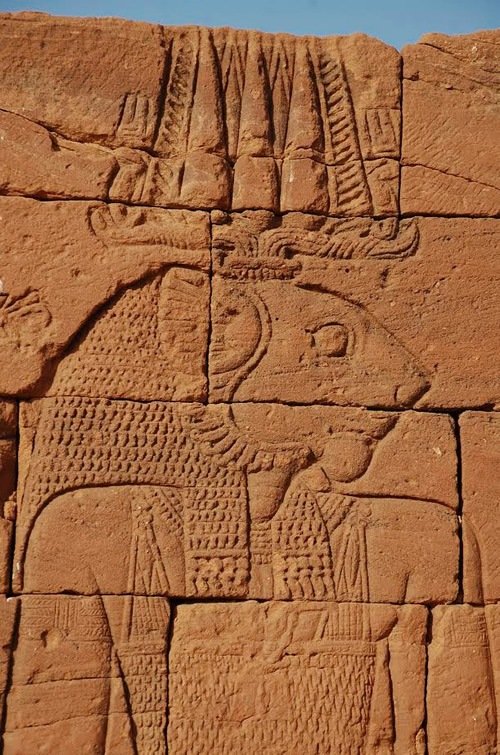 |
| Warrior-god with lion head adorns a temple at the site of Naga. |
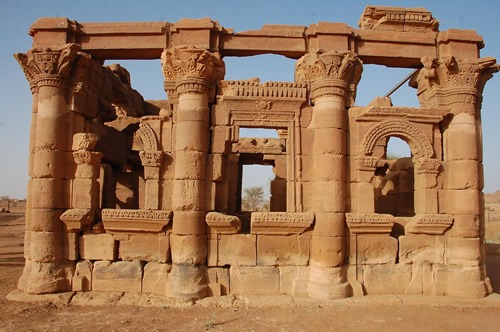 |
| “The kiosk” demonstrates clearly the combined influence of ancient Greek, Roman, and Egyptian cultures. |
Another Apedemak temple can be found 20 km north of Naga, in Musawwarat El-Sufra, together with an enormous labyrinth-like building complex called "the Great Enclosure," where four Kushite queens used to spend periods of their lives. An unusually large number of elephants are depicted here, suggesting the importance of the animal in this area.
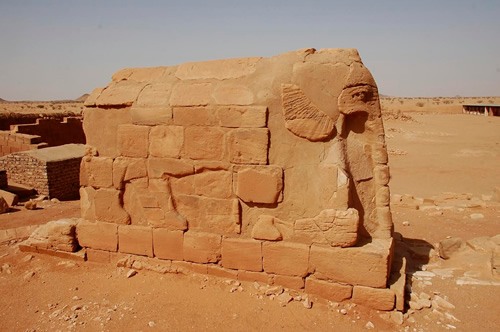 |
| Elephant sculpture at the "Great Enclosure" complex. |
Yet another cultural highlight of the trip is the Royal Necropolis of Meroe, where more than 40 pyramids, located on top of a hill amidst scenic sand dunes, dramatically preside over a wide valley, against the backdrop of a contrasting deep-blue sky. Each pyramid has its funerary chapel, with walls depicting a king’s life as well as offerings to the gods. In June 2011, the archeological sites of Naga, Musawwarat, and Meroe have all been listed as UNESCO World Heritage sites.
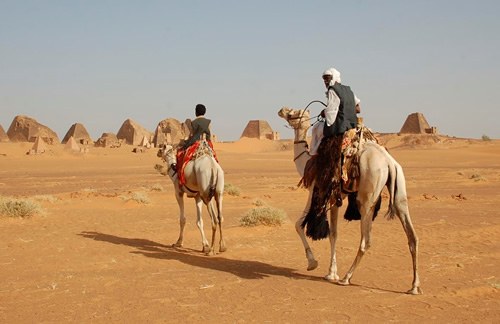 |
| Men riding camels with pyramids of the Royal Necropolis of Meroe in the background. |
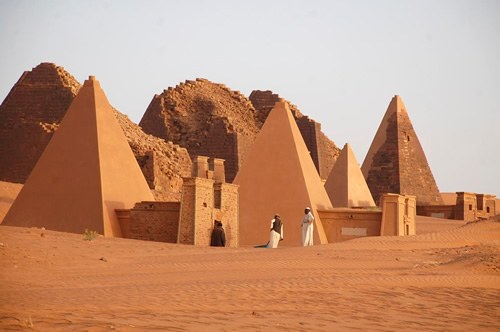 |
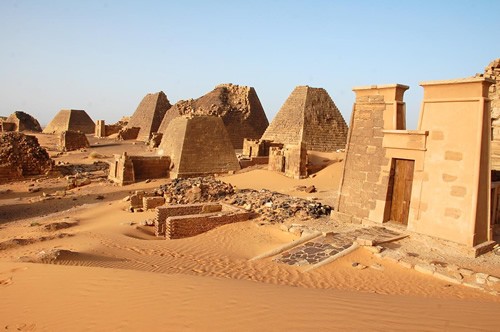 |
| Views of the stunning pyramids. |
Tourism Still in its Infancy
Although The Sudan conjures images of poverty and war for many people, and political instability in Darfur (western Sudan) and in South Sudan (now an independent country, completely split off from The Republic of Sudan since 2011) is still a sad reality, it is considered safe to travel in northern Sudan.
The lack of a fully developed infrastructure and facilities, together with a ban on foreign credit cards has made it hard for The Sudan, however, to become a major tourist attraction, despite all its riches. For us travelers, that means we are practically the only foreigners wherever we go, and we are usually greeted with great hospitality and curiosity by the locals.
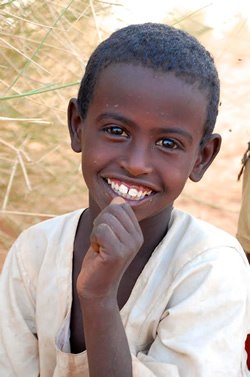 |
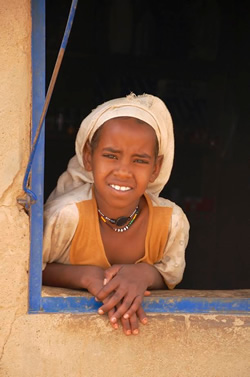 |
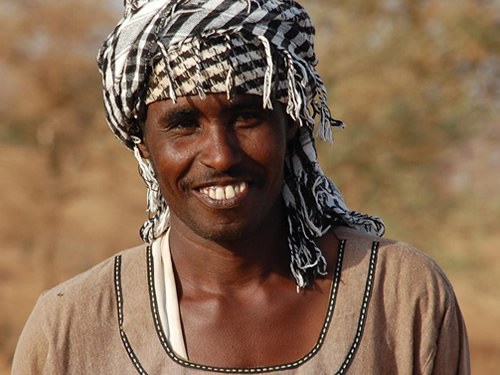 |
| Hospitable locals greet travelers. |
 |
| Many small settlements have big vessels filled with water in front of their place, available to any passerby who is thirsty. |
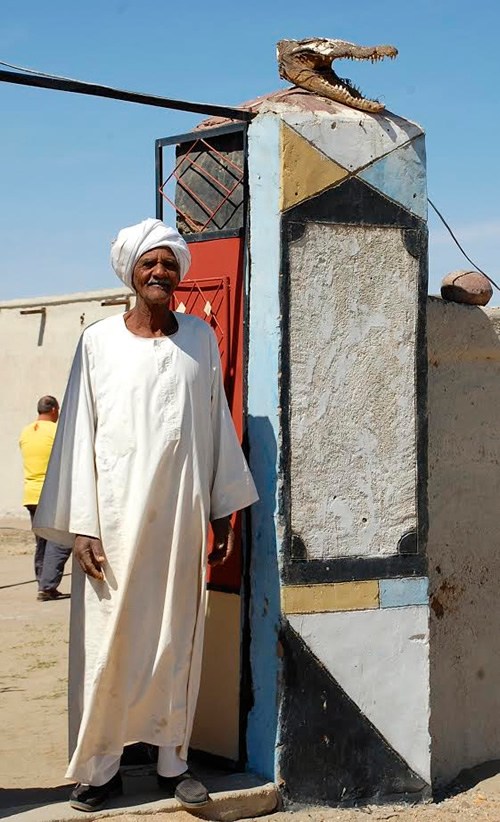 |
| Lunch at a local whose home entrance is adorned with the open mouth of a crocodile, believed to protect the house against evil. |
 |
| A curious family in front of their house with a typical Nubian door. |
Camping in the Wild
Camping in the desert is a magical experience. During the late afternoon, when the sun goes down, the sand dunes begin to glow a spectacular golden yellow, and at night, our remote locations — far away from city lights — lend themselves perfectly for stargazing. And what can be more decadent than in that setting being served karkade, a type of hibiscus juice (The Sudan is a "dry" country, so alcohol is strictly forbidden!), and platters full of culinary masterpieces, miraculously whipped up on only one ring by our talented cook Bakhir, who once reigned over the kitchen of Khartoum’s best hotel?
Because we are a group of only eight travelers, we can all have our own 2-person igloo tent, which we pitch ourselves each night while the crew unloads the vehicles and sets up tables, chairs, and a makeshift kitchen. Foam sleeping mats are also provided, but we have brought our own sleeping bag, towel, and pillow.
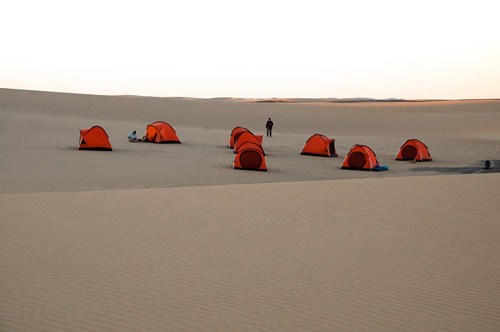 |
| Camping in the desert: silence, space, and star gazing. |
In spite of warm and sunny weather during the day (around 25 Celsius in February), the nights in the desert can be very cold. A few times, my 3-season sleeping bag does not suffice, and shivering like a leaf, I have to resort to extra fleeces, pants, and socks, and tie a sweater around my head to make it through the chilly night.
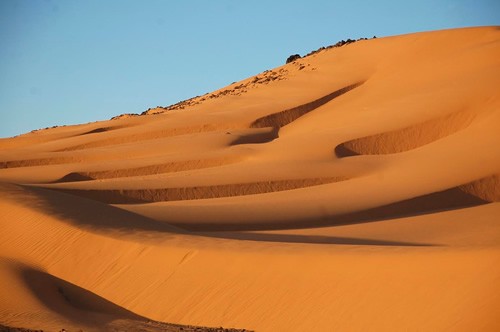 |
| Sand dunes in late afternoon when it is still warm. |
Drinking water is always available, and for a quick sponge down at night and in the morning, there are small hand-basins and jerry cans with limited amounts of water, depending on whether we have passed a well on a given day. Nobody in the group seems too worried about the lack of proper shower or toilet facilities during our expedition. The prospect of staying for two nights in a good hotel halfway through the trip seems enough of an incentive to make do with wet wipes, put up with greasy hair, and answer the calls of nature in the wild. But boy, does it ever feel good, after eight days of roughing it, to finally enjoy that hot shower, wash away all residues of a ferocious sandstorm earlier that week, and sleep in a most comfortable bed!
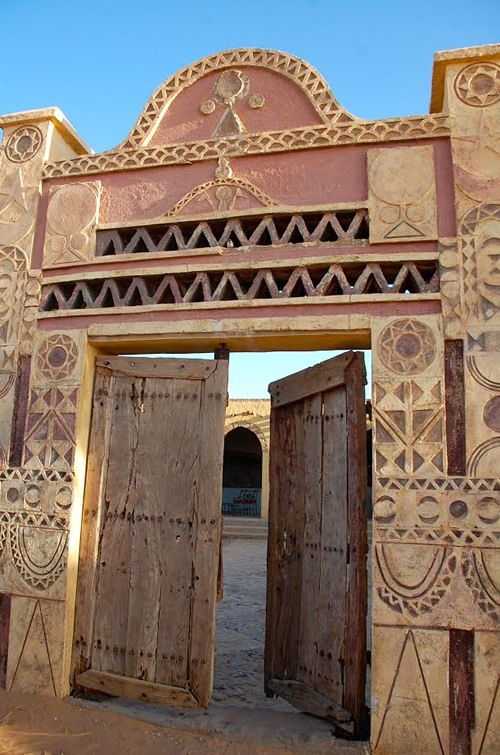 |
| Ancient Nubian door of our hotel for one night. |
Friday Gatherings at the Hamid Al-Nil Mosque in Omdurman
When we return to Khartoum, we get an opportunity to pay a visit to the colorful weekly gathering of the Sudanese Sufis (a particular branch of Islam) at the Hamed al-Nil mosque in Omdurman, the capital’s twin city. The many sounds, scents, and sights we are suddenly bombarded with come as somewhat of a shock to our sensory system.
Worshippers with dervish sticks in hand, donning cloaks, garments, sashes and hats in green, red, and gold, and adorned with garlands of wooden misbaha (prayer) beads, congregate here every Friday afternoon until well into the night, to dance, chant, meditate and pray together.
Swept up by melodic chants and recitations from the Koran coming out of a crackling sound system, dervishes partake in a ritual of fast spinning dances, to perform the devotional acts of zikr (finding one’s inner path to God). In a large circle, formed around a troupe of musicians with drums, tambourines, and cymbals, people clap hands, stomp feet, and jump and swirl in an ever-increasing speed until they fall more and more into a trance. The dust clouds produced by their swift movements, and the smoke of burning incense rising from the surrounding vendor stalls into the thick and heavy air, add even more mystery to this spectacle. It is a long stretch from the infinite space, profound silence, and starry skies of the mesmerizing desert to this unexpected spiritual frenzy at the green and gold Omdurman mosque. But either way, spellbinding it certainly is!
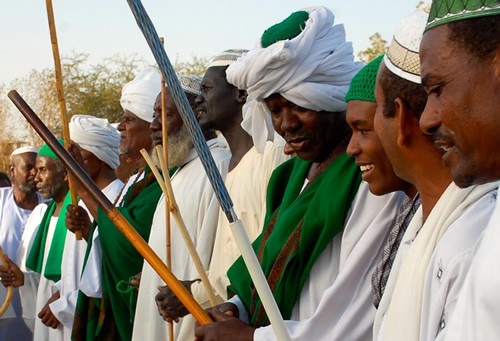 |
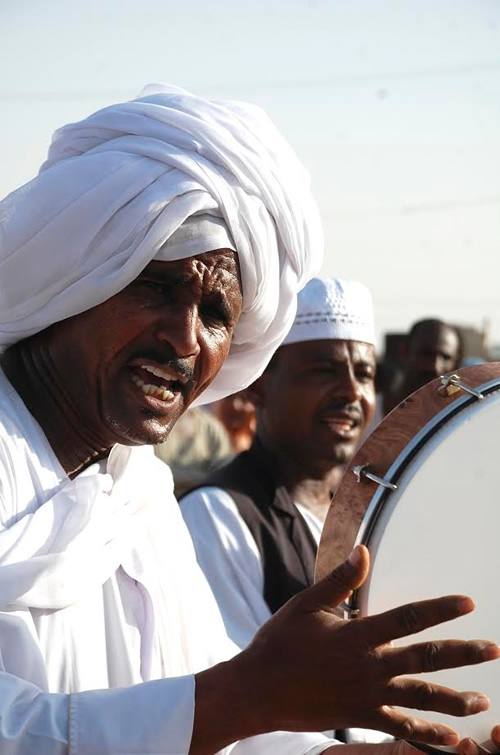 |
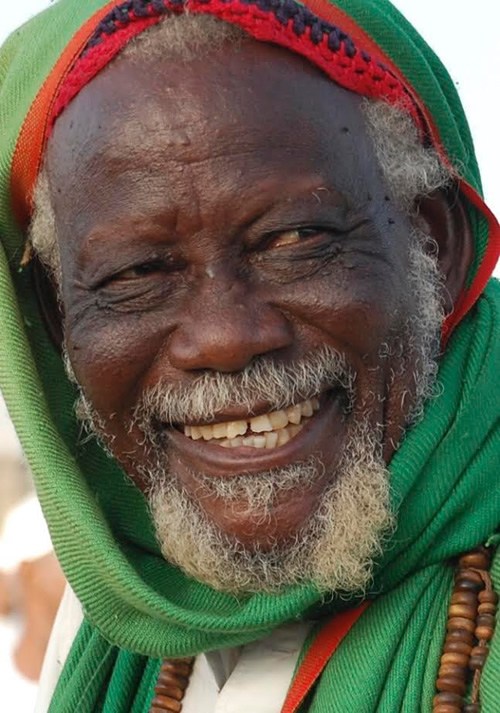 |
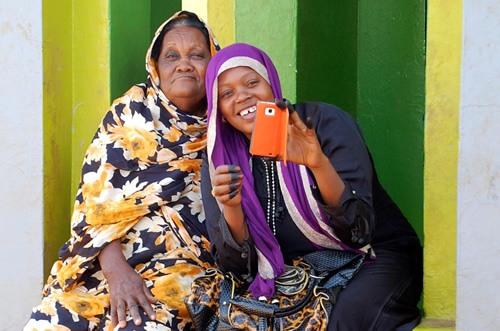 |
| Sufi men and women gather in Khartoum, celebrate with music, song, dance, and even take digital images of the rituals. |
The organization of this expedition is in the capable hands of "The Italian Tourism Company" in Khartoum. They promote responsible travel by employing only local staff (apart from the Italian manager), using solar panels in their tented camp, minimizing non-disposable rubbish and water bottles on tour, and supporting two humanitarian organizations in the Nubian region of The Sudan.
Lies Ouwerkerk is originally from Amsterdam, The Netherlands, and currently lives in Montreal, Canada. Previously a columnist for The Sherbrooke Record, she is presently a freelance writer and photographer for various travel magazines.
|
